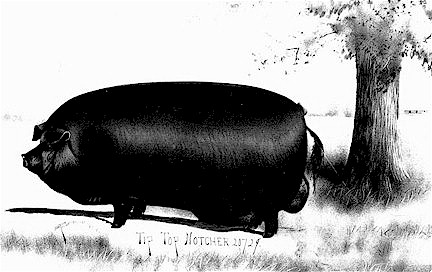
Agricultural History Series |
Missouri State University |
1904 St. Louis World's Fair
Thanks to Don Brooks for sharing information about the Duroc Jersey hogs exhibited by his great grandfather, George W. Seckman, at the 1904 fair. The information below is based on clippings collected by the Seckman family over the years.
Tip Top Notcher

Portrait of Tip Top Notcher 20729
George W. Seckman became famous (at least among hog farmers) at the 1904 Louisiana Purchase Exposition where he showed the champion boar, "Tip Top Notcher." The noteworthy feature of the champion boar was that he weighed 1,120 pounds. He had been raised on Seckman's farm in near Ripley, Cooperstown Township, Brown County, Illinois. Seckman bought the hog via mail order from Cedarville, Ohio in the spring of 1903. The sire and grandsire of Tip Top had been champions themselves. But at one year and 660 lbs., Tip Top Notcher was considered a freak when entered into the State Fair in Springfield, Ill., in 1903. However, he placed first in his class and also at Kansas City's American Royal the same year.
At the World's Fair, exhibitors were allowed to enter a maximum of two animals per class. Seckman entered eight hogs. Most of his animals did well, but it was Tip Top Notcher that earned him the most notoriety. Tip Top Notcher was not considered a freak in St. Louis as he had been the year before. In fact, some later claimed that it was Tip Top Notcher that set the style for large-type hogs that became popular starting in 1904.
Not only was Tip Top Notcher named Champion Duroc Boar at the World's Fair, he also sired some of the other winning hogs shown by Seckman. This included Helen Blazes III who became the first Duroc sow to sell for $1,000.
 |
Seckman ad that details 1904 Fair winnings. |
Tip Top Notcher became so well known that farmers from all over were bringing their sows to Illinois to be bred to the famous boar. Mr. Seckman even had a special spring wagon built so that Tip Top Notcher could be comfortably transported. However, in 1906, Seckman received an offer he couldn't refuse and sold the hog for $5,000. Tip Top Notcher continued to sire many grand champions. No one knows how many offspring he sired, but the number must have been in the thousands.
|
|
By 1909, Tip Top Notcher became crippled, George, who
was sentimentally attached to the big boar, bought him back for only $200. The big
boar died a few months later and was buried on the Seckman farm. A few years later, the United Duroc Swine Association recognized the impact that Tip Top Notcher had had on the breed. They constructed a memorial on a two-acre plot about 2 miles east of Mt. Sterling, IL on Route 24. It was deeded to the State of Illinois which in turn became a small picnic area. The limestone marker is 3-4 feet tall. The inscription to the left is from the memorial marker. In 1922 George Seckman moved to Oklahoma where he had dreams of making a fortune in oil. He was engaged in the real estate and insurance business until his health failed and he retired about four years prior to his death. He was buried in the Mt. Sterling, Illinois city cemetery, only a couple of miles from his big boar.
|
|
|
Bob Brewer of Quincy, IL was driving from Beardtown to Quincy, IL in December, 2005. He stopped along the highway and photographed Tip Top Notcher's memorial obelisk. Bob enhanced the scan a bit but you can see that the marker is easily readable. Thanks Bob. Photo from Bob Brewer.
|
| Frances McCabe Bishop wrote
"In our family history the story is told that my Grandfather, James
Joseph McCabe was a part
owner of Tip Top Notcher at some point in his life. My grandfather
lived in Brown County. Hersman, IL was the area in which he lived.
Our story is that the boar was owned by 4 or
5
men in a partnership of some kind. Then bought by one man. After Tip
Top Notcher's death the man was so sad that he put up the monument." |
Photos from Don Brooks.
This page was designed and is maintained by Lyndon Irwin.
Go back to the Duroc page.
Go back to the World's Fair page.